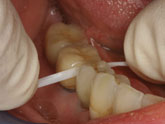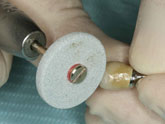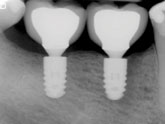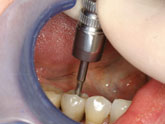Screw-retained implant crowns
Choosing a screw-retained crown or bridge to secure onto dental implants is a great alternative to a cemented restoration. This offers a more secure bond than cement and removes any possibility of the complications that excess cement can occasionally cause.
With screw-retained restorations becoming more and more popular, we have prepared an article to help when fitting them.
It’s always the contacts!
 When fitting an occlusally screw-retained crown it is very important to check with floss how tight
the contact points are, before tightening the screw. If the contacts feel tight before the screw is
turned, they will be much too tight once it is fully secured. In these circumstances it is essential
to reduce the contact point of the crown on the tightest side and re-check with floss.
When fitting an occlusally screw-retained crown it is very important to check with floss how tight
the contact points are, before tightening the screw. If the contacts feel tight before the screw is
turned, they will be much too tight once it is fully secured. In these circumstances it is essential
to reduce the contact point of the crown on the tightest side and re-check with floss.

Once the contacts have been checked and adjusted, the occlusal screw can be tightened. After a few turns, but before the screw starts to get tight, re-check the contacts, and continue to reduce them as necessary. To prevent the chance of an open contact, only ever reduce one contact point of the crown at a time (the one that feels tightest) before re-checking with floss. Finally, tighten the occlusal screw all the way and check the contacts again, removing the crown and adjusting as needed until a perfect fit has been achieved. The built-in torque control on the Ankylos screwdriver will prevent any chance of over-tightening the screw.
Occlusion
 Once the occlusal screw is tightened,
a baseline periapical x-ray must be
taken. Then check the occlusion, both in
centric occlusion and in every excursive
movement the patient’s jaws can make.
Once the occlusal screw is tightened,
a baseline periapical x-ray must be
taken. Then check the occlusion, both in
centric occlusion and in every excursive
movement the patient’s jaws can make.
Screw hole
 Complete the crown by sealing the screw
hole with PTFE tape (or cotton-wool) and
a temporary filling material (e.g. Cavit,
Coltasol etc)
Complete the crown by sealing the screw
hole with PTFE tape (or cotton-wool) and
a temporary filling material (e.g. Cavit,
Coltasol etc)
Re-tighten after one month
 A brief review appointment should be
arranged after one month. The temporary
filling should be removed (an ultrasonic
scaler does this most easily) and the
screw re-tightened until the torque
control on the screwdriver starts to
click, at the preset torque of 15Ncm.
The screw hole can then be re-sealed
with PTFE tape and composite, and the
occlusion re-checked on completion.
A brief review appointment should be
arranged after one month. The temporary
filling should be removed (an ultrasonic
scaler does this most easily) and the
screw re-tightened until the torque
control on the screwdriver starts to
click, at the preset torque of 15Ncm.
The screw hole can then be re-sealed
with PTFE tape and composite, and the
occlusion re-checked on completion.
Equipment
Both the short screwdriver (supplied free from Ankylos) and a longer screwdriver (which must be purchased separately) are required. It varies as to whether a long or a short screwdriver is ideal for each individual case, but most dentists feel more comfortable having both available.Summary
Although this may sound like a time consuming process, a screw-retained crown is usually much quicker to fit than a cement retained crown, without any concerns about excess cement and the final results will speak for themselves.
